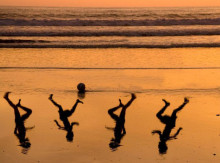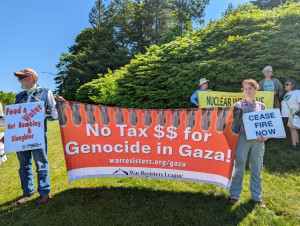In 1995 on the 50th anniversary of the atomic bombings of Hiroshima and Nagasaki, the Smithsonian Air & Space Museum unveiled a radically scaled back exhibition that glorified the bombings, prominently presenting Enola Gay (the Hiroshima bomber) as if it were a holy relic.
The original draft text of the exhibit had been an even-handed history and evaluation of the August 6 and 9, 1945 bombings. But caving to howls of the American Legion and conservative members of Congress, the Smithsonian deleted all criticisms of the bombings and presented a sanitized version without graphic images of the destruction. Instead, they highlighted how the plane was restored, showed photos of machinery, interviews of the Enola Gay crew, and stressed how “the bombings were necessary” to save American lives.
Consequently, WRL with other peace groups formed the Enola Gay Action Coalition to prepare for protests at the opening, as well as to create our own exhibit “Hiroshima, Nagasaki, and 50 Years of Nuclear Terror”—as an answer to the Smithsonian’s crude attempt at censorship and historical revisionism….




